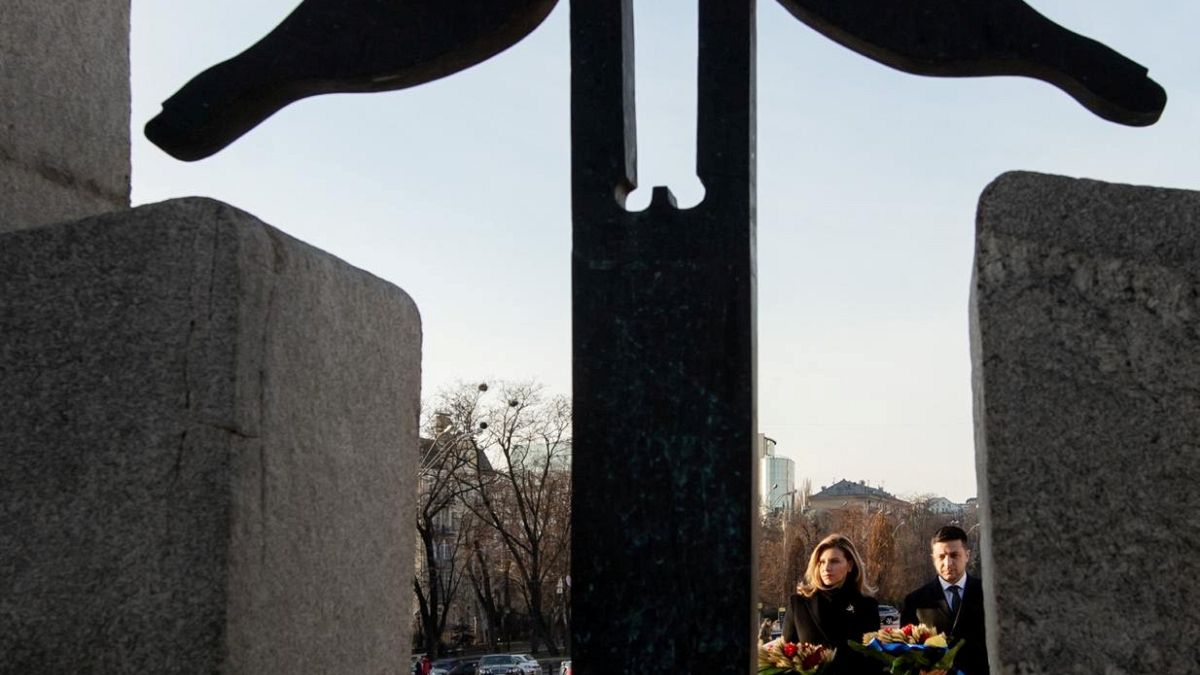A famine killed millions in Soviet Ukraine in the 1930s. Today, Ukrainians remember its victims.
Ukrainians are lighting candles in memory of the millions of people who died in Soviet Ukraine during the Holodomor of 1932-33.
What is Holodomor?
It was a famine that most historians consider was provoked by the repressive policies of Soviet policies.
It hit peasants in Soviet Ukraine and some regions of Soviet Russia, Belarus and Kazakhstan.
Joseph Stalin’s so-called “collectivisation” programme forced peasants to give up their land and property.
The wealthiest were deported and collective farms were formed to take over the running of the land.
This policy led to agriculture production drops and food shortages. Food requisitions by the state from collective farms and households followed, which led to people starving.
Besides the famine of 1932-33, Ukrainians also suffered from other famines between 1921 and 1923 as well as 1946-1947. The term “Holodomor” often referred to those periods too.
Holodomor is a term derived from two Ukrainian words: “holod” (hunger) and “mor” (extermination).
How many people died?
Historians cannot fully agree on this.
Estimates range from almost two million to as many as ten million, but most scholars, both Ukrainian and international, put the figure between around 3 and 3.9 million deaths in Ukraine, with between 5.5 and 8 million people estimated to have perished across the USSR as a whole.
Was it a genocide?
This question divides researchers too. Many historians believe the Holodomor was a genocide against Ukraine as a nation due to the number of political decrees aimed specifically at Ukrainian peasants.
Letters exchanged between communist party leaders reveal that at the time they were worried about Ukrainian peasants rebelling against the agricultural policy.
After crop confiscations, special raids were organised to retrieve any hidden food supplies in households, while a travel ban was also put in place for Ukrainians, preventing them from searching for food elsewhere.
Other scholars argue that mass-famine was a result of political decisions, but was directed at peasants in general rather than Ukrainians specifically.
According to some of them, since a lot of Ukrainians lived in villages and worked on a very fertile ‘black soil’ they suffered most.
Some of the historians even accuse the West of helping to provoke the mass famine by causing the price of grain crops to drop.
Russia has accused Ukraine of politicising this question on multiple occasions. It insists it to be a common tragedy as other regions in the Soviet Union suffered too.
This position was publicly shared by the former president of Ukraine Viktor Yanukovich, ousted from power in 2014.
The country’s law, however, recognises Holodomor as an act of genocide and has criminalised its denial since 2006, although no prosecutions for this crime have ever taken place.
A recent survey by the Ukrainian sociological group Rating reveals that 82% of Ukrainians think that Holodomor was an act of genocide against the Ukrainian people. 11% of Ukrainian nationals don’t support this idea, while 7% are undecided.
Abroad, more than 20 countries recognise Holodomor as an act of genocide against Ukrainians, among them Spain, Italy, Poland, Hungary, USA, Canada, Australia, Argentina, Mexico and Colombia.
In a resolution in 2008, the European Parliament called Holodomor "an appalling crime against the Ukrainian people, and against humanity".
What were the peasants eating in the starving villages?
Food aid was sometimes sent from other regions but was often returned by the authorities.
To survive, peasants were collecting frozen or rotten potatoes and onions left on the fields after harvesting.
They were also catching and cooking mice, squirrels, cats, dogs, frogs, lizards and turtles.
Pancakes and soups were made from nettle, orache, other kinds of weeds and flowers, cherry tree branches, ground apple and blackthorn wood, aspen and birch bark and old animal bones.
There were thousands of cases of cannibalism, with little children often being victims.
Why is so little known about the tragedy of the Holodomor in the West?
After the first international reports, in 1933 the Soviet state denied foreign journalists access to the territories suffering from famine.
Later, communist authorities drew the curtain over the question.
It only started to be discussed again in the 1980s, notably after the Chernobyl disaster, which was covered-up by authorities.
The Holodomor remains an open wound for Ukrainians.
The horrific testimonies from the period of mass starvation were passed within families from generation to generation, consequences of that experience still influencing society today.
How is the Holodomor remembered?
The Holodomor is remembered in Ukraine on the fourth Saturday of November every year.
On this day many Ukrainians light candles at the windows of their homes.
Both official and informal memorial events and prayer services are held across the country and by Ukrainians abroad.
Ukraine’s president, Volodymyr Zelenskyi, and other senior officials participate in Holodomor remembrance at the ‘National Museum of the Holodomor-Genocide’ in Kyiv.
